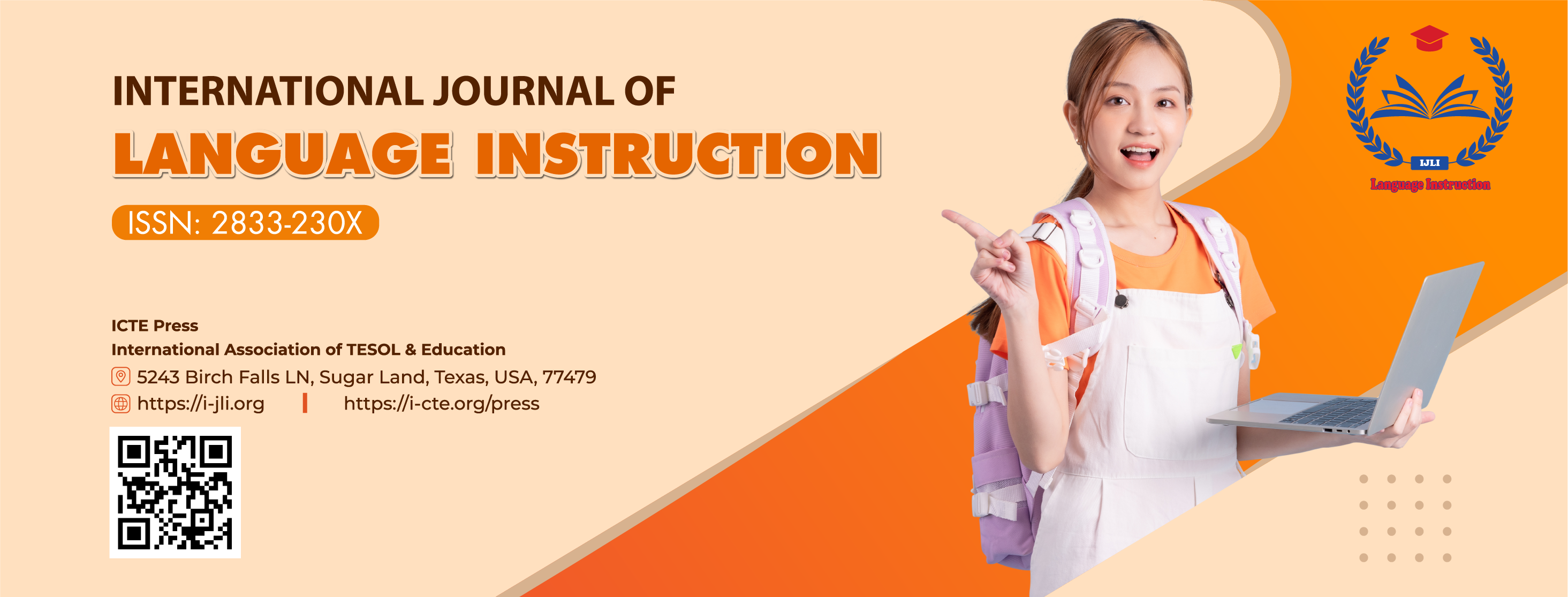The Effects of Using Education Technology Tools on Learning Grammar for Students in Secondary School
DOI:
https://doi.org/10.54855/ijli.22115Keywords:
Educational technology tools, effect, cultivate, grammarAbstract
Technology has become an indispensable part of modern life, and this is also true in education, especially during today's Covid-19 pandemic when students have to study online and offline. Educational technology and especially technology tools are used in teaching and learning English to promote teachers' teaching process to be more active, proactive, and creative, and also to help students have a more active and effective way of learning. In addition, technology helps teachers design their lessons more lively and attractive and provide extra lessons outside of regular school hours to help students understand the content of the lectures deeply, complete their assignments and expand their knowledge, especially grammar. This study focuses on the effects of using technology and technology tools in cultivating grammar for students, remarkably in supporting students in online learning. In this article, researchers have given definitions of technology tools, grammar, and types of tools commonly used in the process of teaching and learning grammar; thereby, teachers have the right choice for each type of technology tool for their lesson. At the same time, it also significantly improves the teaching and learning process when technology is applied.
References
Al Seyabi, F., & Tuzlukova, V. (2014). Writing problems and strategies: An investigative study in the Omani school and university context. Asian Journal of Social Sciences & Humanities, 3(4), 37–48.
Anderson, G., & Arsenault, N. (2005). Fundamentals of educational research. Routledge.
Azar, B. (2007). Grammar-based teaching: A practitioner’s perspective. Tesl-Ej, 11(2), n2.
Bikowski, D. (2018). Technology for teaching grammar. The TESOL Encyclopedia of English Language Teaching, 1–7.
Brinton, L. J. (2000). The structure of modern English: A linguistic introduction. John Benjamins Publishing.
Cowan, R. (2008). The teacher’s grammar of English with answers: A course book and reference guide. Cambridge University Press. https://books.google.com.vn/books?id=WCCk829jmzUC
Creswell, J. W., & Poth, C. N. (2016). Qualitative inquiry and research design: Choosing among five approaches. Sage publications.
Dastjerdi, N. B. (2016). Analyzing the opportunities and challenges to use of information and communication technology tools in the teaching-learning process. Indian Journal of Science and Technology, 9(6), 1–8.
Fraenkel, J. R., Wallen, N. E., & Hyun, H. H. (2012). How to design and evaluate research in education (Vol. 7, p. 429). New York: McGraw-hill.
Mart, Ç. T. (2013). Teaching grammar in context: Why and how? Theory & Practice in Language Studies, 3(1), 124-129.
Alsied, S. M., & Pathan, M. M. (2013). The use of computer technology in EFL classroom: Advantages and implications. International Journal of English Language & Translation Studies (IJ-ELTS), 1(1), 61-71.
Pham, N. S. (2022). The Effectiveness of Teaching and Learning Online: A Study on HUFI’s English-majored Students. International Journal of TESOL & Education, 2(3), 1–12. https://doi.org/10.54855/ijte.22231
Samantha, F. (2021, November 18). What Is Educational Technology (EdTech)? BestColleges. https://www.bestcolleges.com/blog/what-is-educational-technology/
Scrivener, J. (2013). Teaching grammar—Oxford Basics. Oxford University Press.
Shahid, F., Aleem, M., Islam, M. A., Iqbal, M. A., & Yousaf, M. M. (2019). A review of technological tools in teaching and learning computer science. Eurasia Journal of Mathematics, Science and Technology Education, 15(11), em1773.
Son, J.-B. (2018). Teacher Development in Technology-Enhanced Language Teaching. Springer.
Tamang, R. S., & Rinchen, S. (2021a). The Impact of Educational Technology Tools on the Learning Achievement of B. Ed. Science Students in Ecology Class at Samtse College of Education. Contemporary Education and Teaching Research, 2(1), 1–11.
Tamang, R. S., & Rinchen, S. (2021b). The Impact of Educational Technology Tools on the Learning Achievement of B. Ed. Science Students in Ecology Class at Samtse College of Education. Contemporary Education and Teaching Research, 2(1), 1–11.
Uong, T. G. T., Nguyen, D. K., & Nguyen, H. N. (2022). Teachers’ Feedback on Using Discord as an Online Learning Platform. International Journal of TESOL & Education, 2(4), 84–104. https://doi.org/10.54855/ijte.22246
Warnock, S. (2009). Teaching writing online: How and why. National Council of Teachers of English Urbana, IL.
Downloads
Published
Issue
Section
License
Copyright (c) 2022 Tu Thi Hong Phuong

This work is licensed under a Creative Commons Attribution-NonCommercial 4.0 International License.
The copyright of all articles published in the International Journal of Language Instruction (ijli) remains with the Authors, i.e. Authors retain full ownership of their article. Permitted third-party reuse of the open access articles is defined by the applicable Creative Commons (CC) end-user license which is accepted by the Authors upon submission of their paper. All articles in the ijli are published under the CC BY-NC 4.0 license, meaning that end users can freely share an article (i.e. copy and redistribute the material in any medium or format) and adapt it (i.e. remix, transform and build upon the material) on the condition that proper attribution is given (i.e. appropriate credit, a link to the applicable license and an indication if any changes were made; all in such a way that does not suggest that the licensor endorses the user or the use) and the material is only used for non-commercial purposes.
Authors are able to enter into separate, additional contractual arrangements for the non-exclusive distribution of the journal's published version of the work (e.g., post it to an institutional repository, in a journal or publish it in a book), with an acknowledgment of its initial publication in this journal.











